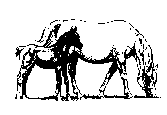The importance of pregnancy checking...
CONFIRMING PREGNANCIES = PEACE OF MIND
Part of the challenge of breeding the mare is confirming the success of our efforts. The mare’s reproductive cycle is twenty one days long (that is, twenty one days from ovulation to ovulation, or from the first day of the heat cycle to the first day of the next heat cycle, etc.) In about seventy five percent of the mares the first regular heat cycles (heat cycles that last about five days and repeat every twenty one days) occur in late March and early April. After foaling, the first ovulation will be nine to ten days later and is usually accompanied by signs of heat (thus the name, “foal heat”). The second heat after foaling is three weeks after the foal heat, or about thirty days after the foal is born.
With these basic facts of life out of the way, we can proceed with confirming pregnancy in the mare. The traditional method of pregnancy checking the mare is to trailer her to the stallion once or twice three weeks after she was bred. If she tolerates his male antics, then she is not pregnant and is bredagain. If she refuses the stallion’s overtures and tries to kill him instead, she is pregnant. If the mare teases (shows some of the signs of heat), but when the stallion tries to mount she fidgets around or lashes out determinedly, she may or may not be pregnant. More than likely in this situation the mare will be restrained and bred anyway.
The use of ultrasound has allowed us to intensify the breeding process. With a little confinement, the mare can be examined for pregnancy fourteen days or later after the last breeding. If the exam is done within 14-18 days of breeding, the mare can be found pregnant before she is due to come into heat. If she is not pregnant, plans can be made to take her to her suitor or to order semen for home delivery. We can also give you some idea as to when she will need to be with the stallion for optimal breeding. This is especially important when the first breeding was during foal heat.
While we consider foal heat breeding to be on the ninth or tenth day, sometimes the mare has her own ideas. She may ovulate from five to fifteen days after foaling. The next heat may be from day twenty five to thirty five, instead of on the thirtieth day as we assume.
When examined by ultrasound, the embryo itself can be evaluated. In a fair number of cases the embryo will be degenerating. They have lived for a few days and then start dying. The causes of this degeneration are many. They range from a conception with aged or damaged sperm or egg, to an adverse uterine environment that destroys the embryo as it drops from the oviduct.
In addition to not resulting in pregnancy, the very presence of the little stinker will fool the mother into thinking she is pregnant. This will prevent her from coming into heat the next heat and maybe the next one. By now, if you have been hauling her to the stallion, you have seen no signs of heat and are breaking out the champagne to celebrate the pregnancy.
If the mare stays pregnant, or thinks she is pregnant for sixty days, the ovaries start retiring from their job of producing progesterone (the pregnancy hormone). Once they start digressing, they will usually wait until next year to become active again. If the retarded embryos go undetected, they may keep the mare out of heat for this sixty days, and ultimately the rest of the year.
The other very important reason for using ultrasound for diagnosing pregnancy is to identify the presence of twins. A pregnancy with twins is very bad news in the horse. Very few of these pregnancies make it all the way through gestation, and only a fraction of this small number are born alive. wareness of the twins at such an early stage allows the mare owner to take measures: eliminate one or both twins. The preference is to have only one embryo, which results in a much higher number of births.
CLICK BELOW TO DISPLAY A PRINTER-FRIENDLY COPY OF THIS ARTICLE
Select "Open this file from its current location," if you just want to print it out,
it will open in a simple word processing application, select the print button.
(unless you want to save this article in your computer's memory)

 ConfirmingPregnancies_PeaceOfMind.rtf
ConfirmingPregnancies_PeaceOfMind.rtf